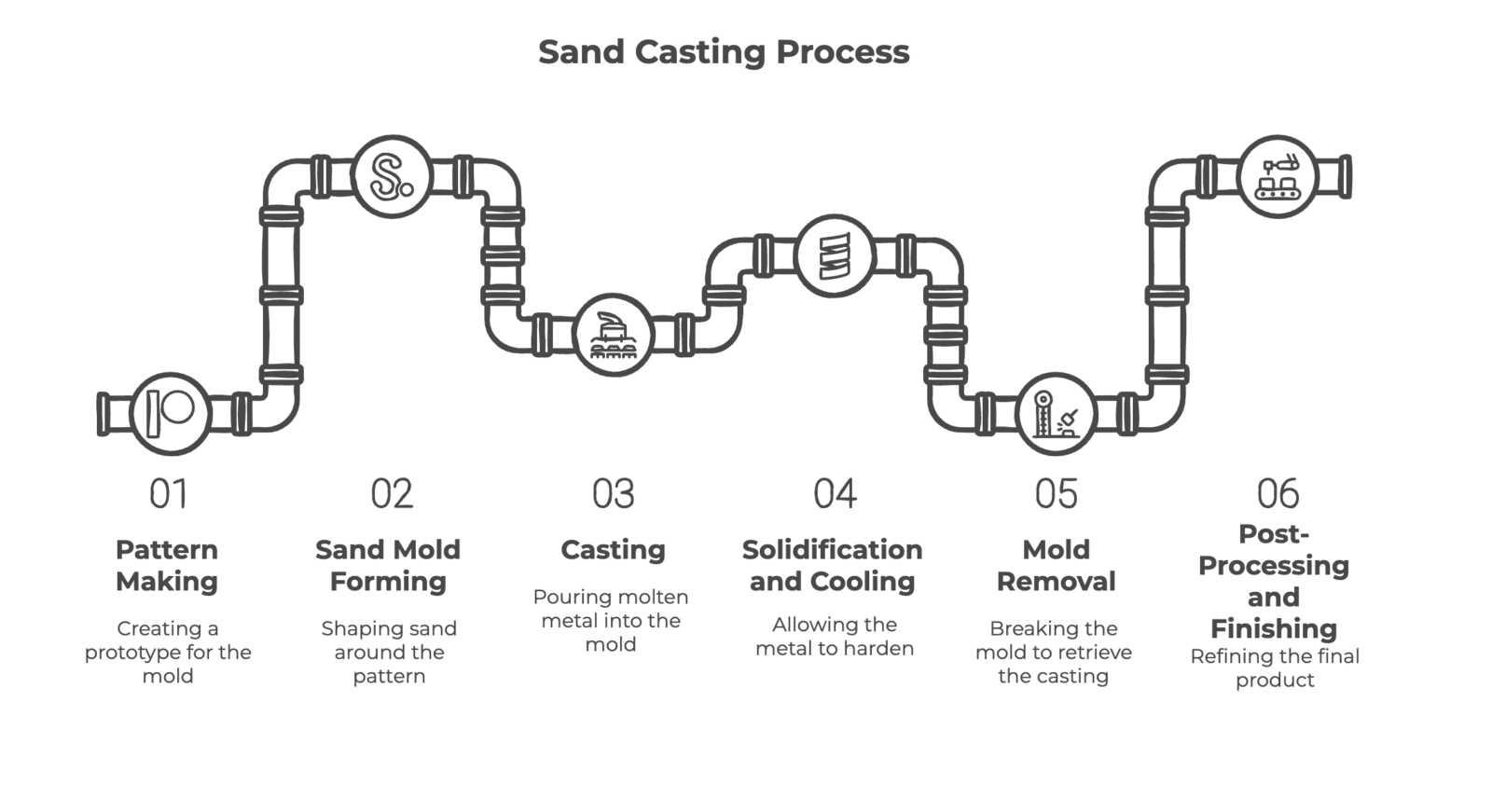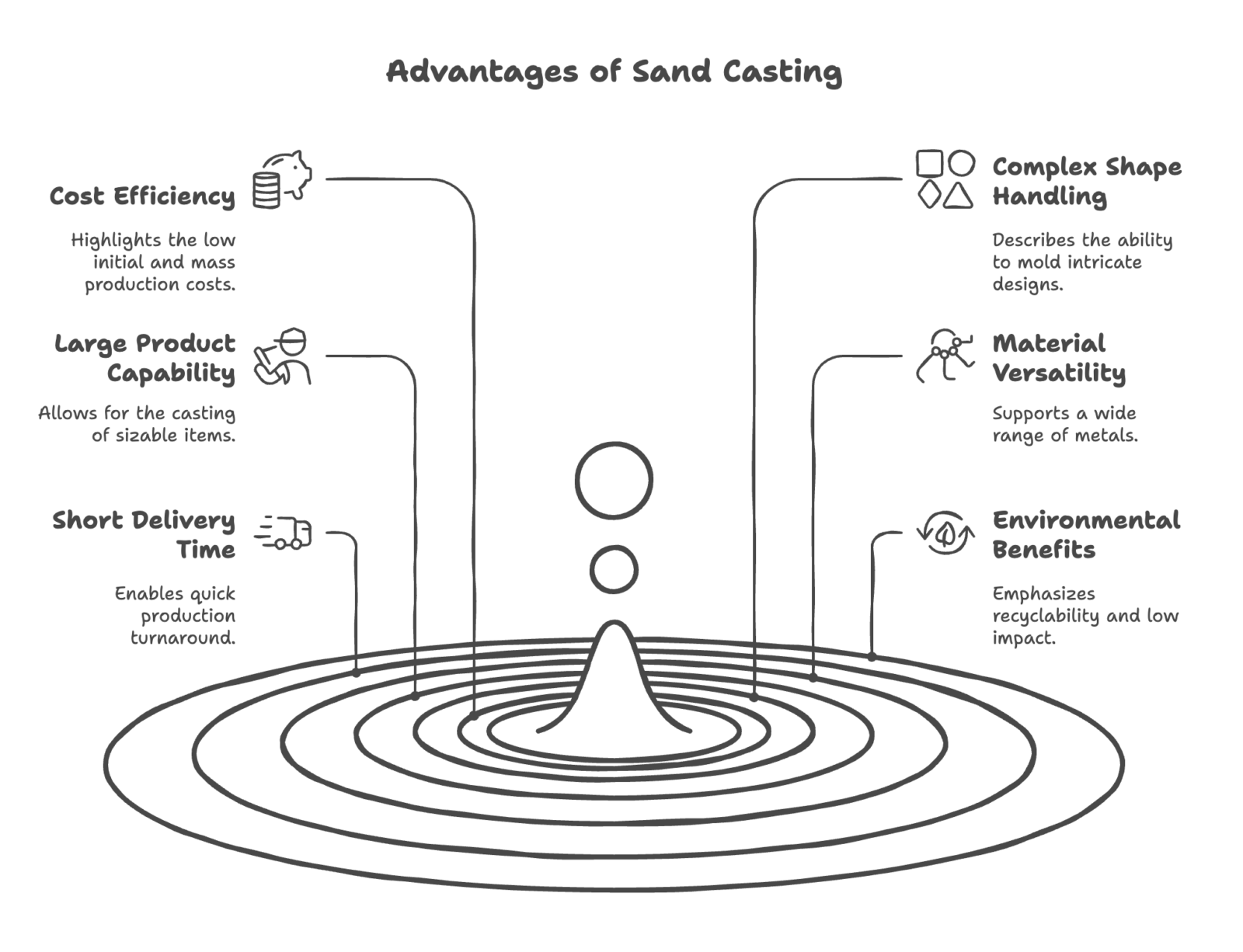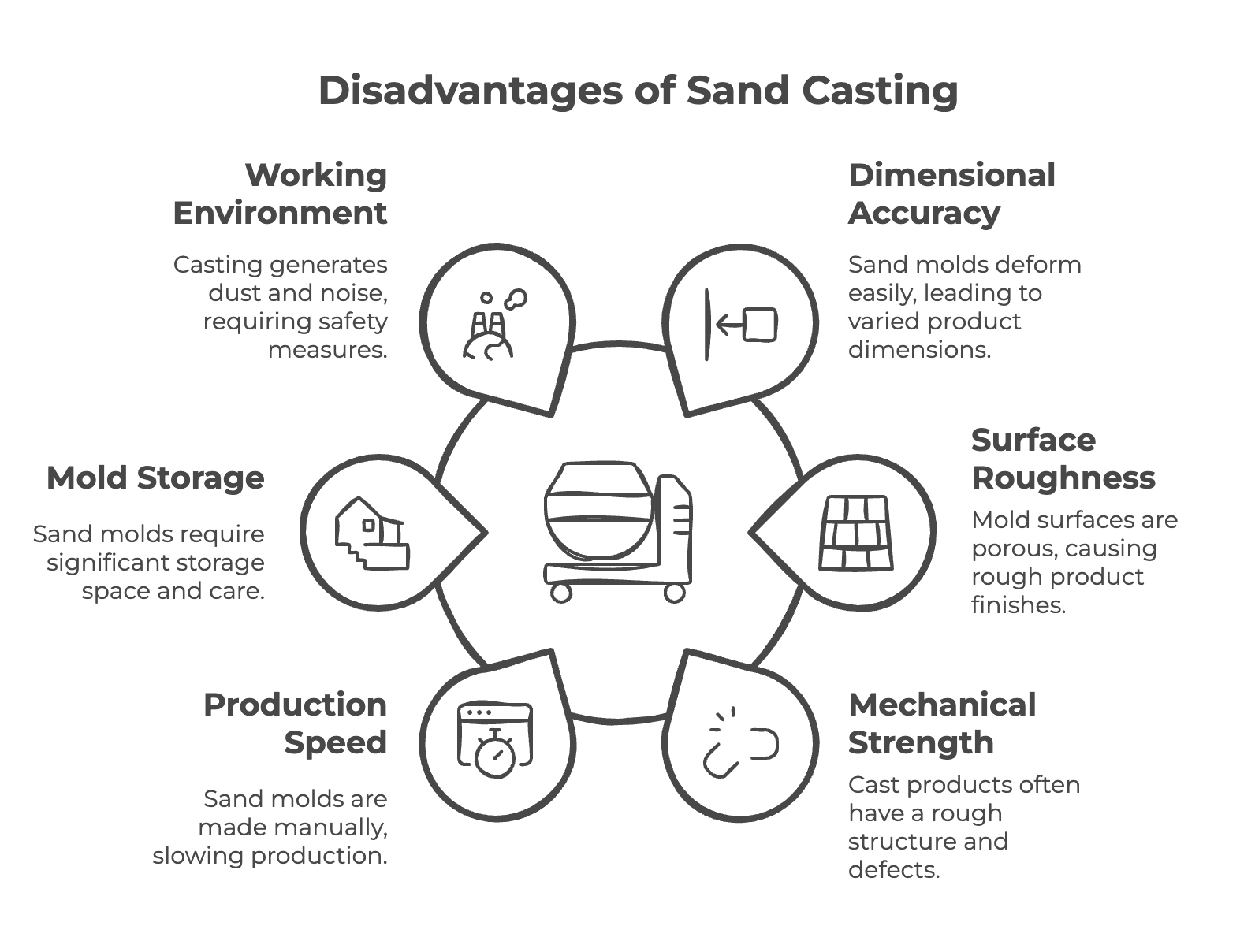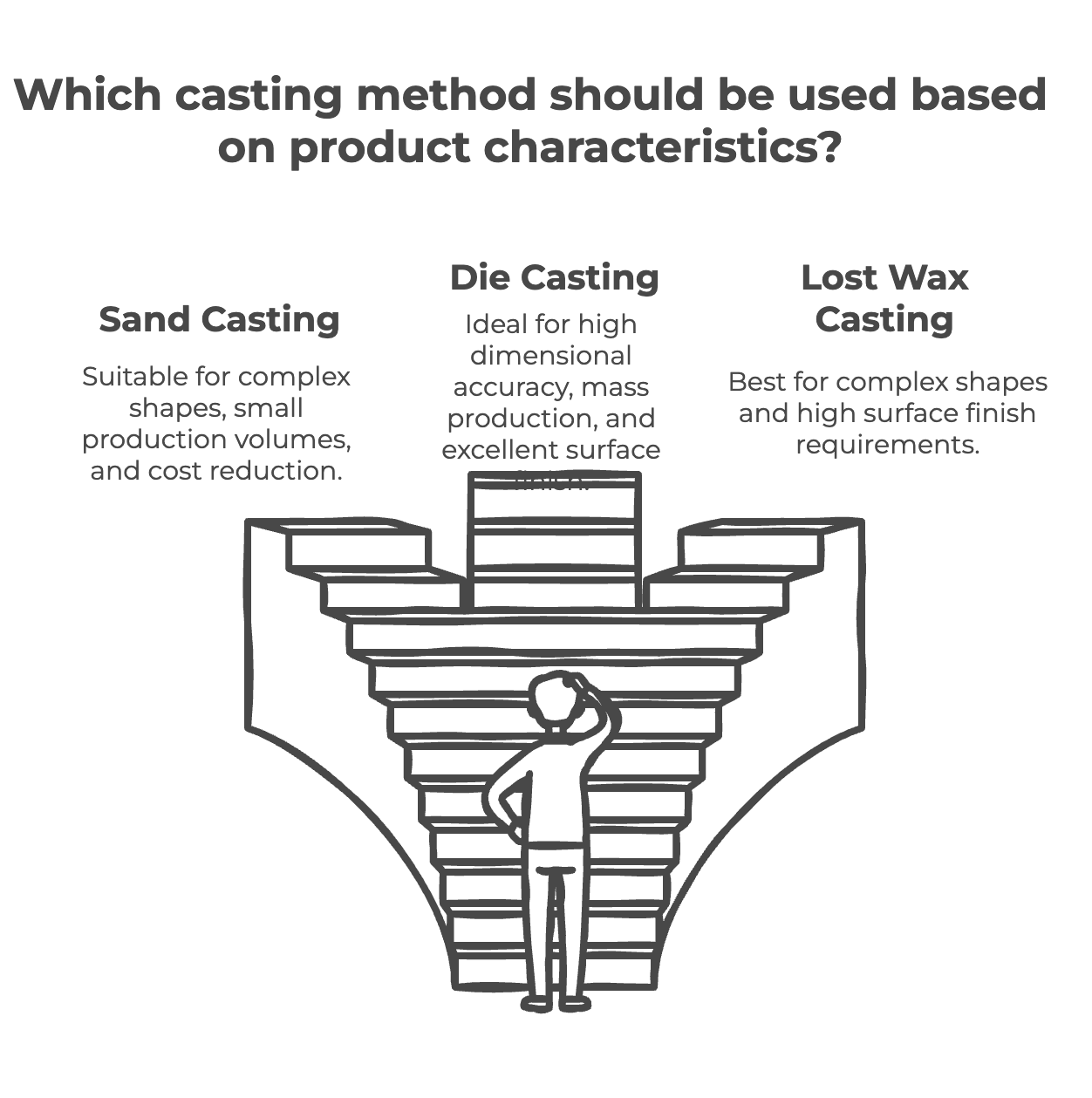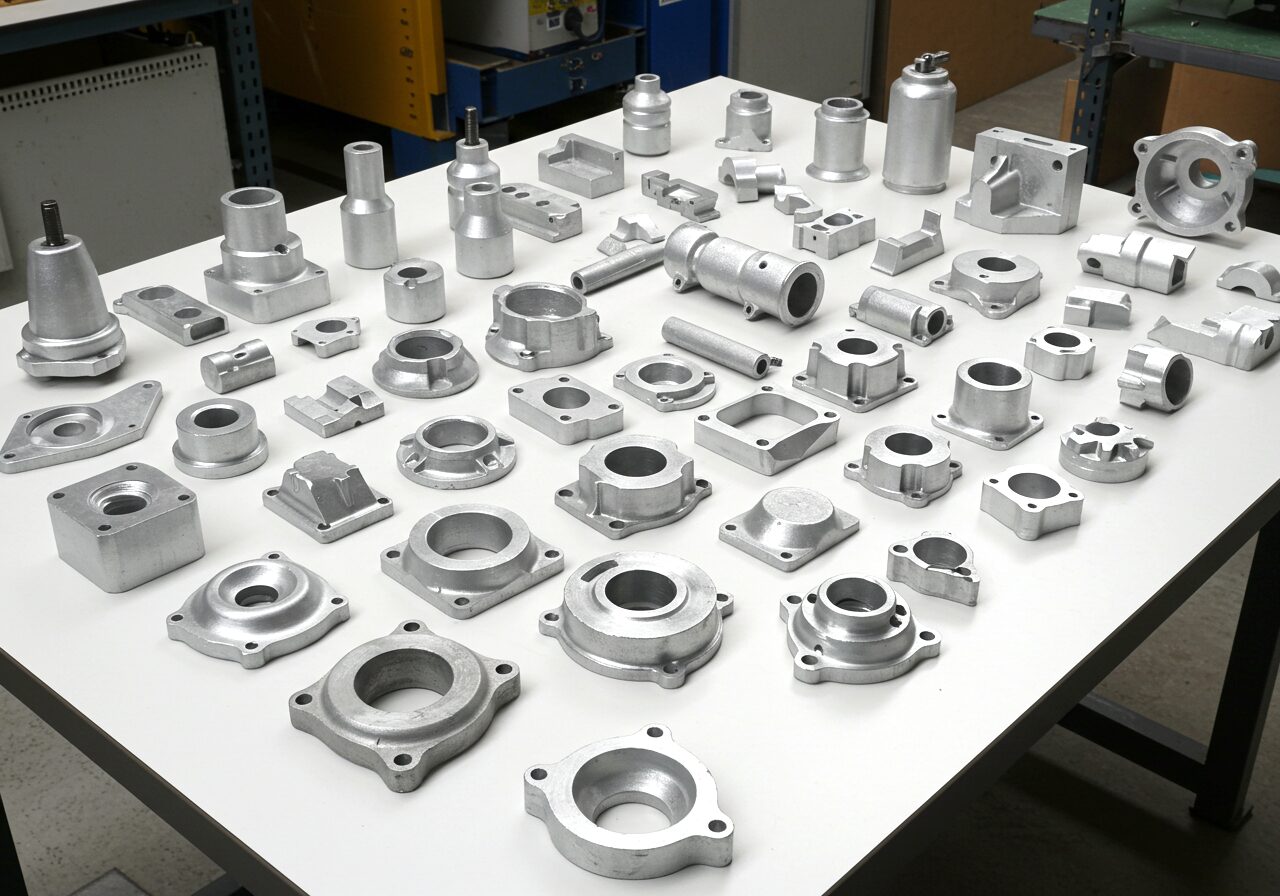◆Table of contents
ToggleIntroduction
Aluminum casting is used in various products around us. Its applications range from automobile parts to home appliances and building materials. Although there are various methods of aluminum casting, sand casting is one of the oldest casting methods.
Sand casting is a method of forming a product by using sand as a mold material and pouring molten aluminum into it. It is characterized by being able to manufacture products with complex shapes at a relatively low cost and is suitable for high-mix low-volume production.
This article aims to deepen your understanding of sand casting by explaining the sand casting process, its advantages and disadvantages, and comparisons with other casting methods.
Sand Casting Process
Sand casting is a casting method that uses sand as a mold material. It is characterized by being able to manufacture products with complex shapes at a relatively low cost and is suitable for high-mix low-volume production. Here, we will explain the specific process of sand casting with illustrations and introduce the points and precautions for each process.
Specific Sand Casting Process
- Pattern MakingFirst, a pattern that accurately reproduces the shape of the product is made. The pattern is made of wood, metal, plastic, or other materials. The pattern is the prototype for making the sand mold, so its accuracy greatly affects the quality of the product.
- Sand Mold FormingThe pattern is covered with sand, and a sand mold is made using a flask. The sand mold is divided into an upper mold and a lower mold, and the shape of the pattern is transferred to each. The sand mold is provided with a path (runner) through which the molten metal flows and ventilation holes through which gas is discharged.
- CastingThe aluminum alloy melted in the melting furnace is poured from the pouring basin of the sand mold. The molten aluminum travels through the runner and fills every corner of the sand mold, filling the cavity along the shape of the pattern.
- Solidification and CoolingWait for the molten aluminum to cool and solidify in the sand mold. The solidification time varies depending on the size and shape of the product and the type of aluminum alloy.
- Mold RemovalOnce the aluminum alloy has sufficiently solidified, the sand mold is broken and the product is removed. Since the sand mold can only be used once, a new sand mold must be made each time.
- Post-Processing and FinishingThe removed product has traces of the runner and pouring basin, burrs, etc., so post-processing is performed to remove these. If necessary, surface treatment or machining is performed to complete the product.
Points and Precautions for Each Process
- Pattern Making: Accurate pattern making is important because the accuracy of the pattern affects the quality of the product.
- Sand Mold Forming: The strength and air permeability of the sand mold affect the occurrence of defects during casting, so it is necessary to select the appropriate sand and consider the forming method.
- Casting: The temperature and pouring speed of the molten aluminum, the shape of the runner, etc. affect the occurrence of casting defects, so it is necessary to set appropriate conditions.
- Solidification and Cooling: It is necessary to select an appropriate cooling method considering shrinkage and distortion during solidification.
- Mold Removal: It is necessary to carefully break the sand mold so as not to damage the product.
- Post-Processing and Finishing: Appropriate processing such as deburring and surface treatment should be performed according to the product’s application and required quality.
High-quality aluminum castings can be manufactured by observing the points and precautions for each process in the sand casting process.
Advantages of Sand Casting
Sand casting has superior properties in various aspects compared to other casting methods. Here, we will explain the specific advantages of sand casting, divided into cost, manufacturing, material, and other advantages.
Cost
- Initial Cost: A major advantage of sand casting is that the initial cost of mold production is relatively low. Sand molds are easier to produce than wooden or metal molds, and the material costs are also lower, making them suitable for small-volume production and prototype production.
- Cost in Mass Production: You might think that sand casting is not suitable for mass production. However, it is possible to handle mass production by introducing automated sand mold forming lines. However, compared to other casting methods such as die casting, the cost of mass production tends to be slightly higher.
Manufacturing
- Ability to Handle Complex Shapes: Sand casting is suitable for manufacturing products with complex shapes. Sand molds can be manufactured in separate parts, making it easy to mold complex shapes. Also, by incorporating sand mold parts called cores, it is possible to manufacture products with cavities inside.
- Ability to Handle Large Products: Sand casting can also handle the manufacture of large products. Sand molds can be manufactured for large products by using large flasks.
- Suitability for High-Mix Low-Volume Production: Sand casting is suitable for high-mix low-volume production. Because the initial cost of mold production is low, costs can be reduced even in small-volume production. Also, since sand molds can be manufactured in a relatively short period, a wide variety of products can be produced flexibly.
Material
- Types of Materials That Can Be Used: Sand casting can cast various types of metals. It can handle a wide range of materials, including iron, copper, and stainless steel, as well as aluminum alloys.
Other Advantages
- Short Delivery Time: Since sand molds can be manufactured in a relatively short period, product manufacturing with short delivery times is possible.
- Environmental Impact: The sand used in sand casting can be recycled. Also, materials with low environmental impact can be used for sand mold forming.
As described above, sand casting has various advantages in terms of cost, manufacturing, material, and other aspects. By taking advantage of these benefits, it contributes to product manufacturing in various fields.
Disadvantages of Sand Casting
While sand casting has many advantages, it also has some disadvantages. Here, we will take a closer look at the disadvantages of sand casting from the perspectives of quality, productivity, and others.
Quality
- Dimensional Accuracy: Sand casting tends to have lower dimensional accuracy compared to other casting methods. Because sand molds have lower rigidity than wooden or metal molds, they are easily deformed by the pressure and heat of molten metal. As a result, the dimensional accuracy of products tends to vary.
- Surface Roughness: Products made by sand casting have the disadvantage of rough surface roughness. Because sand molds are made by binding sand particles with a binder, the surface tends to be porous, and the product surface becomes rough as molten metal enters the gaps between the sand particles.
- Mechanical Strength: Products made by sand casting are generally considered to have low mechanical strength. This is because the structure of products made by sand casting is rough and casting defects are likely to occur. However, it is possible to improve mechanical strength by performing appropriate casting conditions and post-processing.
Productivity
- Production Speed: Sand casting has the disadvantage of slow production speed. Sand molds are made manually one by one, making them unsuitable for mass production. Also, since sand molds can only be used once, a new sand mold must be made each time a product is made.
Other
- Mold Storage: Sand molds require storage space. Especially for sand molds for large products, it may be difficult to secure storage space. Also, since sand molds are vulnerable to humidity and temperature changes, it is necessary to prepare an appropriate storage environment.
- Working Environment: Sand casting has the aspect that the working environment is harsh. Sand mold forming and casting work tend to generate dust and noise, and since high-temperature molten metal is handled, it is necessary to pay close attention to safety management.
As described above, sand casting has several disadvantages in terms of quality, productivity, and others. When choosing sand casting, it is important to understand these disadvantages and choose the optimal casting method considering the required quality, production volume, and cost of the product.
Comparison of Sand Casting with Other Casting Methods
In addition to sand casting, there are various other methods for aluminum casting. Each casting method has its own characteristics, advantages, and disadvantages, and it is important to select the optimal method according to the characteristics of the product to be manufactured. Here, we compare sand casting with other representative casting methods to clarify the differences between them.
Main Aluminum Casting Methods
- Die Casting Method: A casting method in which molten aluminum is injected into a metal mold at high speed and high pressure.
- Lost Wax Casting Method: A casting method in which a model made of wax is covered with ceramic, the wax is melted out, and molten aluminum is poured into the resulting cavity.
- Riser Casting Method: A casting method in which molten aluminum is poured into a mold, and molten aluminum is supplied from a part called a riser to compensate for shrinkage that occurs during solidification.
Comparison of Each Casting Method
| Item | Sand Casting | Die Casting Method | Lost Wax Casting Method | Riser Casting Method |
|---|---|---|---|---|
| Characteristics | Make a mold with sand | Inject into a metal mold | Use a wax model | Compensate for shrinkage with a riser |
| Advantages | – Can handle complex shapes – Can handle large products – Low initial cost |
– High dimensional accuracy – Beautiful surface – High mass productivity |
– Can handle complex and precise shapes – Can handle thin-walled products |
– Can make dense castings – Can handle large products |
| Disadvantages | – Low dimensional accuracy – Rough surface – Low productivity |
– Not suitable for complex shapes – High initial cost – Not suitable for large products |
– High cost – Low productivity |
– Difficult to design risers – Requires post-processing such as welding |
| Applications | – Large parts – Complex shaped parts – Small production items |
– Automotive parts – Home appliances – OA equipment parts |
– Aircraft parts – Medical equipment parts – Precision machinery parts |
– Shipbuilding parts – Large machinery parts |
Selection of Casting Method According to Product Characteristics
It is important to select the optimal casting method for the product characteristics to manufacture high-quality products efficiently. The following are the main considerations when selecting a casting method.
- Product Shape: Sand casting and lost wax casting are suitable for products with complex shapes.
- Dimensional Accuracy: Die casting is suitable for products that require high dimensional accuracy.
- Surface Roughness: Die casting and lost wax casting are suitable for products that require a beautiful surface finish.
- Production Volume: Die casting is suitable for mass production, and sand casting is suitable for small-volume production.
- Cost: Sand casting is suitable for those who want to reduce costs, and die casting is suitable for those who want to reduce costs with mass production effects even if they spend initial costs.
By understanding the characteristics of each casting method and selecting the optimal method according to the product characteristics, high-quality aluminum castings can be manufactured efficiently.
Products Suitable for Sand Casting
Sand casting is particularly suitable for manufacturing certain types of products due to its characteristics. Here, we will explain what kind of products sand casting is suitable for, citing specific product examples.
What Kind of Products Are Suitable for Sand Casting?
Sand casting is suitable for manufacturing products with the following characteristics:
- Complex Shapes: Since sand molds can be made in separate parts, products with complex shapes can be manufactured relatively easily.
- Large Products: Sand molds can be manufactured for large products by using large flasks.
- High-Mix Low-Volume Production: Sand molds can be manufactured relatively inexpensively, making them suitable for high-mix low-volume production.
- Prototypes: Since sand molds can be manufactured in a short period, they are suitable for manufacturing prototypes.
From these characteristics, sand casting is particularly suitable for manufacturing the following products.
Specific Product Examples
- Automotive Parts: Complex shaped and large parts such as cylinder blocks, engine parts, and transmission cases.
- Industrial Machinery Parts: Parts that require high strength and durability, such as machine tool parts, pump parts, and valve parts.
- Building Materials: Large and complex shaped materials such as gratings, manholes, and handrails.
- Fine Arts and Crafts: Products that require complex shapes and designs, such as Buddhist statues, crafts, and decorative items.
These products can be manufactured efficiently and with high quality by taking advantage of the characteristics of sand casting.
Product Example: Automotive Parts
Automotive parts are one of the fields where sand casting is widely used. Large parts with complex shapes, such as engine blocks, cylinder heads, and transmission cases, are efficiently manufactured by sand casting.
Product Example: Industrial Machinery Parts
Industrial machinery parts are also one of the products suitable for sand casting. Parts that require high strength and durability, such as machine tool frames, pump casings, and valve bodies, are manufactured by sand casting.
Product Example: Building Materials
In building materials, products with large and complex shapes such as gratings, manholes, and handrails are manufactured by sand casting. These products can achieve both design and functionality by sand casting.
Product Example: Fine Arts and Crafts
In fine arts and crafts, products that require complex shapes and designs, such as Buddhist statues, crafts, and decorative items, are manufactured by sand casting. Sand casting is a casting method suitable for expressing the beauty of these products.
In addition to the above, sand casting is used in the manufacture of products in various fields. Sand casting, with its high versatility, will continue to be used in a wide range of fields in the future.
Summary
Sand casting is attractive because it can manufacture complex shapes and large products at a relatively low cost. It is also suitable for small-volume multi-product production and can be used for prototype production. On the other hand, dimensional accuracy and surface roughness remain challenges.
However, the quality of sand casting is improving with the development of sand mold forming technology using 3D printers and high-precision casting technology.
Sand casting is used in a wide range of fields, including automotive parts, industrial machinery parts, building materials, and fine arts and crafts, and is expected to play an active role in various fields in the future. Efforts to reduce environmental impact are also underway, and it will develop as a more sustainable casting method.

